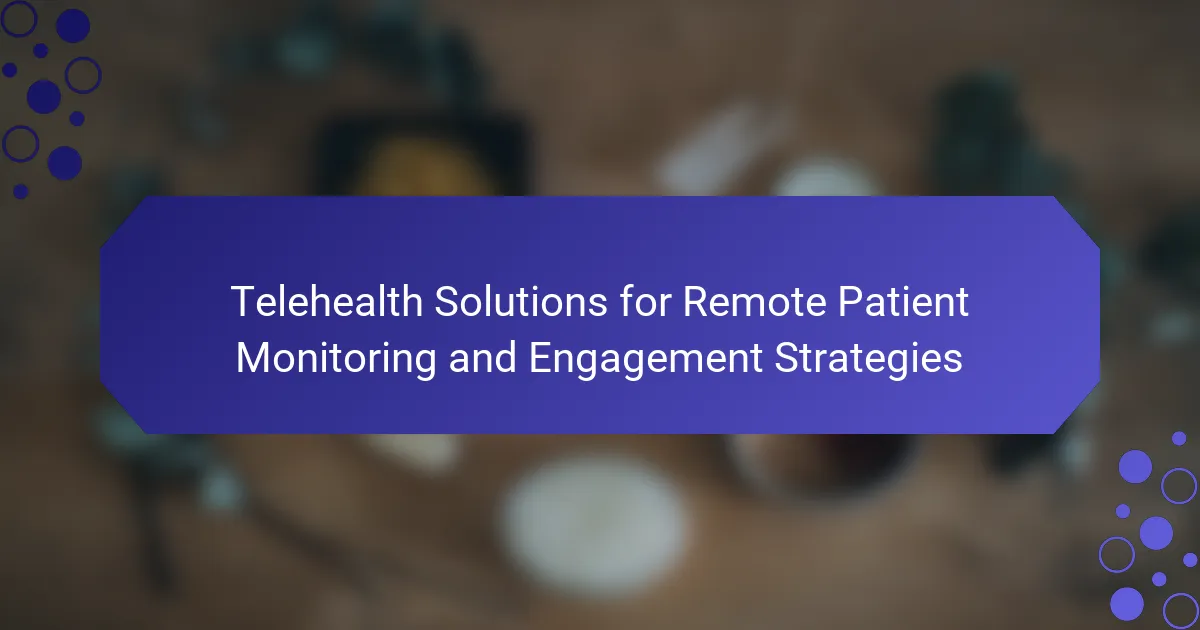Telehealth solutions for remote patient monitoring enhance healthcare access and efficiency while improving patient engagement. Key technologies include wearable devices and mobile health applications that facilitate real-time data tracking. Providers face challenges such as technology integration and regulatory compliance. Understanding patient demographics is crucial for tailoring effective engagement strategies.
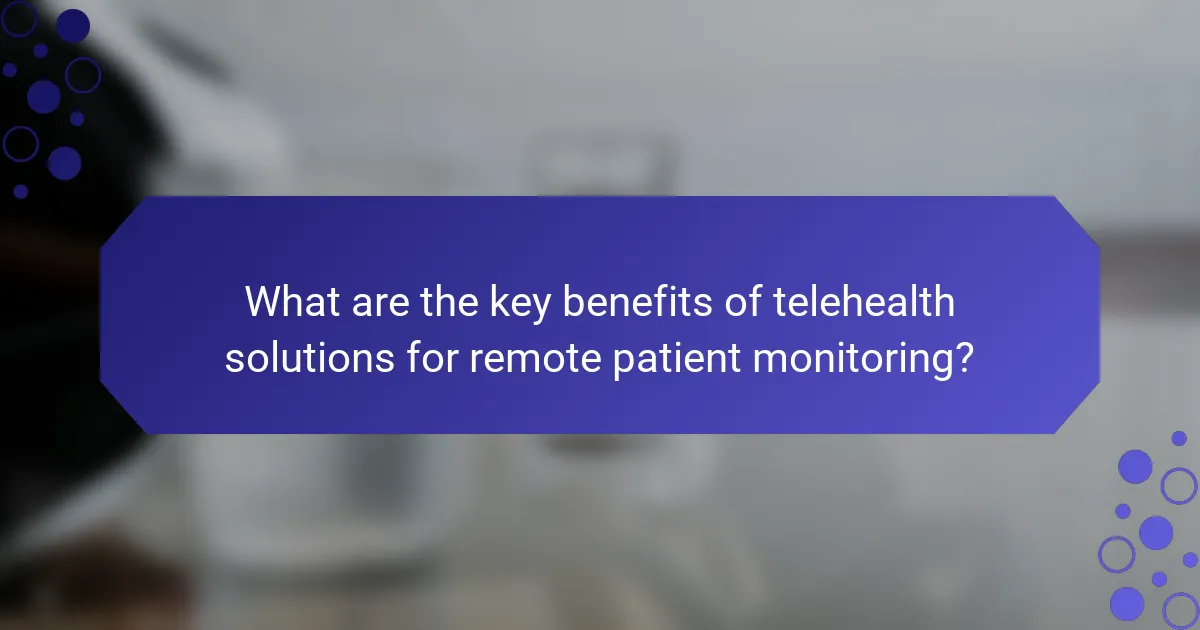
What are the key benefits of telehealth solutions for remote patient monitoring?
Telehealth solutions for remote patient monitoring enhance healthcare delivery by improving access, efficiency, and patient engagement. Key benefits include real-time health data tracking, which allows for timely interventions and personalised care. These solutions reduce hospital visits, saving time and resources. Additionally, they foster better communication between patients and providers, leading to improved health outcomes. Enhanced patient engagement strategies empower individuals to take control of their health, resulting in higher satisfaction and adherence to treatment plans.
How do telehealth solutions enhance patient engagement?
Telehealth solutions significantly enhance patient engagement by providing continuous access to healthcare resources. They facilitate real-time communication between patients and providers, improving adherence to treatment plans. These solutions often include features like reminders for medication and appointments, which actively involve patients in their care. Additionally, telehealth platforms can offer personalised health education, tailored to individual patient needs, fostering a deeper understanding of their health conditions. As a result, patients feel more empowered and involved in their healthcare journey, leading to improved outcomes.
What role does data security play in telehealth solutions?
Data security is crucial in telehealth solutions, ensuring patient information remains confidential and protected. Effective data security measures, such as encryption and secure access controls, foster trust between patients and providers. The rise of remote patient monitoring increases the need for robust security protocols to safeguard sensitive health data. As telehealth adoption grows, maintaining compliance with regulations like HIPAA becomes essential for protecting patient privacy and enhancing engagement strategies.
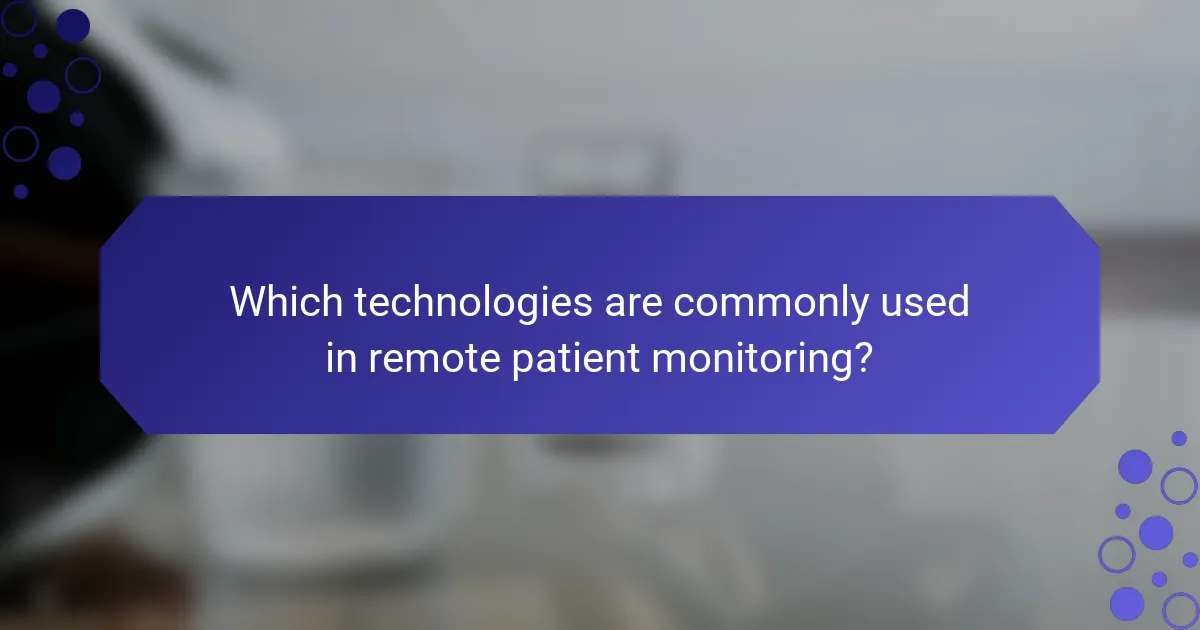
Which technologies are commonly used in remote patient monitoring?
Common technologies in remote patient monitoring include wearable devices, mobile health applications, telehealth platforms, and remote monitoring systems. These tools facilitate real-time health data collection and enhance patient engagement. Wearable devices, such as smartwatches, track vital signs continuously, while mobile health applications allow patients to input data and communicate with healthcare providers. Telehealth platforms enable virtual consultations, improving accessibility to care. Remote monitoring systems aggregate data from various sources, providing comprehensive insights into patient health.
How do wearable devices integrate with telehealth platforms?
Wearable devices seamlessly integrate with telehealth platforms by enabling real-time data collection and patient monitoring. These devices, such as smartwatches and fitness trackers, collect vital signs and activity levels, transmitting data directly to healthcare providers. This integration enhances patient engagement through personalised feedback and alerts, fostering proactive health management. Additionally, wearables can facilitate remote consultations, allowing for timely interventions based on the monitored data. As a result, telehealth solutions become more effective, improving patient outcomes and satisfaction.
What are the differences between mobile apps and web-based platforms for telehealth?
Mobile apps provide a more personalised experience, while web-based platforms offer broader accessibility for telehealth. Mobile apps often leverage device features, enhancing engagement through notifications and data tracking. In contrast, web-based platforms ensure easy access across various devices without installation. User interface and experience differ significantly, with mobile apps designed for touch interaction and web platforms optimised for keyboard and mouse. Additionally, mobile apps can function offline, a unique advantage for users with limited connectivity. Web-based platforms, however, usually have fewer technical constraints, allowing for more extensive data processing capabilities.
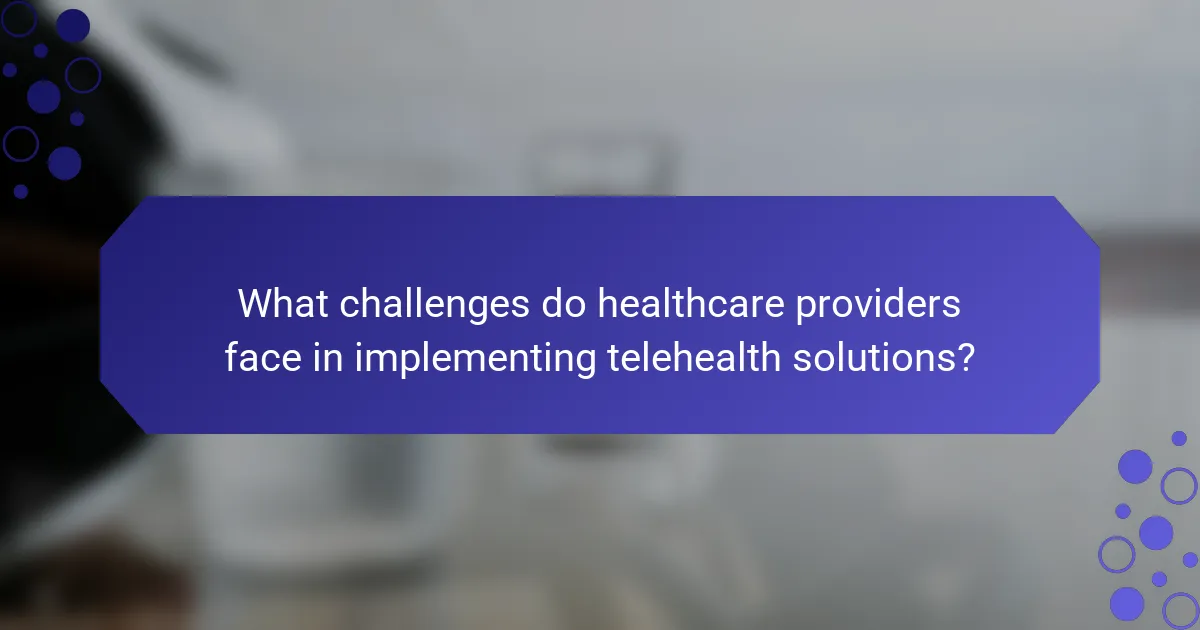
What challenges do healthcare providers face in implementing telehealth solutions?
Healthcare providers face several challenges in implementing telehealth solutions. Key issues include technology integration, patient engagement, and regulatory compliance.
Providers often struggle with integrating telehealth platforms into existing systems, which can disrupt workflows. Additionally, ensuring patient engagement remains a challenge, as some patients may prefer in-person visits.
Regulatory compliance adds complexity, as healthcare laws vary by region and can change frequently. Training staff to use telehealth tools effectively is essential but can be resource-intensive.
Finally, addressing data security concerns is crucial to protect patient information and maintain trust.
How can interoperability issues be addressed in telehealth systems?
Interoperability issues in telehealth systems can be addressed through standardised protocols, data integration frameworks, and robust security measures. Implementing Health Level Seven (HL7) standards facilitates seamless data exchange among different systems. Additionally, utilising Application Programming Interfaces (APIs) enhances compatibility between diverse telehealth platforms. Regular training for healthcare providers on these technologies ensures effective utilisation and minimises discrepancies in data handling. Furthermore, continuous evaluation and updates of interoperability strategies can adapt to evolving healthcare needs, ensuring sustained patient engagement and monitoring.
What are the regulatory considerations for telehealth in different regions?
Regulatory considerations for telehealth vary significantly across regions. Key factors include licensing requirements, reimbursement policies, and privacy laws.
In the United States, states regulate telehealth practices, leading to diverse licensing requirements. For instance, some states allow out-of-state providers to practice via telehealth, while others do not. Reimbursement policies also differ; Medicare covers certain telehealth services, but coverage varies by state for Medicaid.
In the European Union, the General Data Protection Regulation governs patient data privacy. Member states have different telehealth regulations, impacting service delivery and reimbursement. Countries like Germany have established specific telehealth frameworks, while others are still developing their policies.
In Asia, countries like India have introduced guidelines for telemedicine, focusing on patient safety and quality of care. However, regulations can be inconsistent, affecting telehealth adoption.
Understanding these regional differences is essential for effective telehealth implementation and compliance.
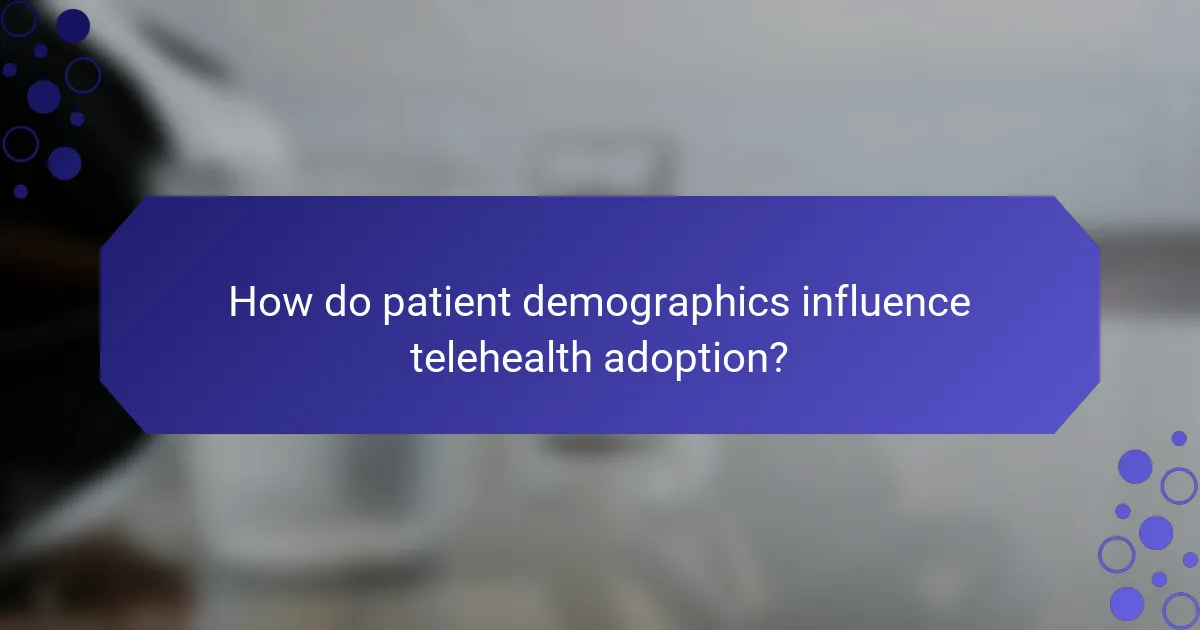
How do patient demographics influence telehealth adoption?
Patient demographics significantly influence telehealth adoption by affecting access, engagement, and usability. Older adults may face technological barriers, while younger populations typically embrace digital solutions. Additionally, socioeconomic status impacts the availability of necessary devices and internet access. Studies show that telehealth adoption rates vary by age group, with millennials leading in usage, while older adults lag due to unfamiliarity. Cultural factors also play a role; certain demographics may prefer in-person consultations due to trust or comfort levels. Understanding these dynamics helps tailor telehealth solutions for effective remote patient monitoring and engagement strategies.
What are the trends in telehealth usage among elderly patients?
Telehealth usage among elderly patients is increasing due to convenience and accessibility. A recent study indicates that 60% of seniors now utilise telehealth services, reflecting a significant rise in remote patient monitoring.
Elderly patients appreciate the ability to consult healthcare providers from home, reducing travel challenges. Engagement strategies, such as user-friendly platforms and personalised follow-ups, enhance adherence to care plans.
Telehealth solutions also address unique attributes of elderly care, including chronic disease management and mental health support. As a result, telehealth is becoming a vital component of comprehensive healthcare for seniors.
Overall, the trend towards telehealth among the elderly is expected to grow, driven by advancements in technology and a focus on patient-centred care.
How do cultural attitudes impact the acceptance of telehealth solutions?
Cultural attitudes significantly influence the acceptance of telehealth solutions. In societies that prioritise traditional healthcare methods, resistance to telehealth may arise due to skepticism about technology. Conversely, cultures that embrace innovation are more likely to adopt telehealth for remote patient monitoring and engagement strategies.
Factors such as trust in technology, familiarity with digital tools, and perceived benefits impact acceptance. For instance, communities with higher digital literacy tend to utilise telehealth services effectively. Additionally, cultural perceptions of healthcare professionals can affect patients’ willingness to engage with telehealth platforms.
Telehealth solutions can enhance patient engagement by offering personalised care and convenience. However, cultural attitudes toward privacy and data security can create barriers. Understanding these cultural nuances is essential for developing effective telehealth strategies that resonate with diverse populations.
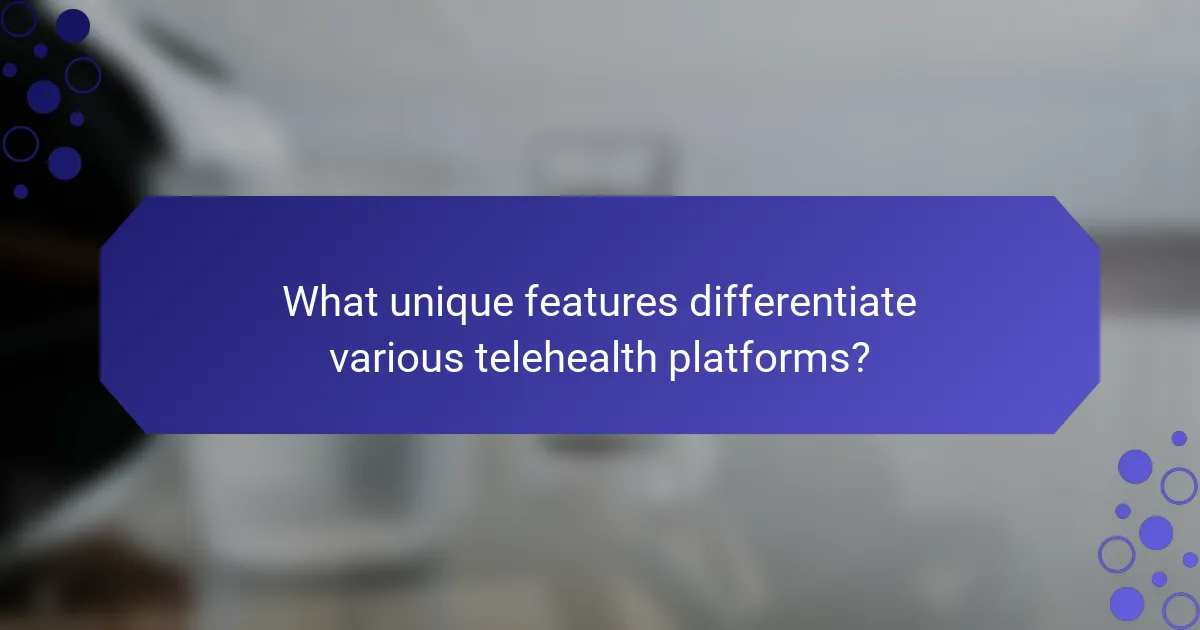
What unique features differentiate various telehealth platforms?
Telehealth platforms differ through unique features such as user interface design, integration capabilities, and security measures. These attributes significantly impact patient engagement and monitoring effectiveness.
User interface design varies, with some platforms offering intuitive layouts that enhance user experience. Integration capabilities with electronic health records streamline data sharing, while robust security measures protect patient information.
Additionally, some telehealth solutions provide advanced analytics tools, enabling healthcare providers to track patient outcomes effectively. Others may offer customisable communication options, catering to diverse patient needs.
These unique features collectively enhance the overall functionality and effectiveness of telehealth solutions in remote patient monitoring and engagement strategies.
How do patient feedback mechanisms vary across telehealth providers?
Patient feedback mechanisms vary significantly across telehealth providers, affecting engagement and service quality. Some providers utilise real-time feedback tools, enabling immediate patient responses. Others rely on periodic surveys or follow-up calls to gather insights. The integration of feedback into care protocols differs, with some platforms actively adapting services based on patient input while others maintain a more static approach. Additionally, the technology used for feedback collection, such as mobile apps versus web-based forms, influences the accessibility and response rates of patient feedback.
What innovative engagement strategies are being adopted in telehealth?
Telehealth is adopting innovative engagement strategies that enhance remote patient monitoring. These strategies include personalised care plans, real-time health data sharing, and interactive patient education tools.
Telehealth platforms now utilise mobile applications to facilitate seamless communication between patients and healthcare providers. This approach fosters greater patient involvement in their health management.
Another significant strategy is the integration of wearable devices that monitor vital signs, enabling proactive health interventions. These devices provide continuous feedback, improving patient adherence to treatment protocols.
Lastly, telehealth is leveraging artificial intelligence to analyse patient data and predict health outcomes. This capability allows for timely interventions and tailored health recommendations, enhancing overall patient engagement.
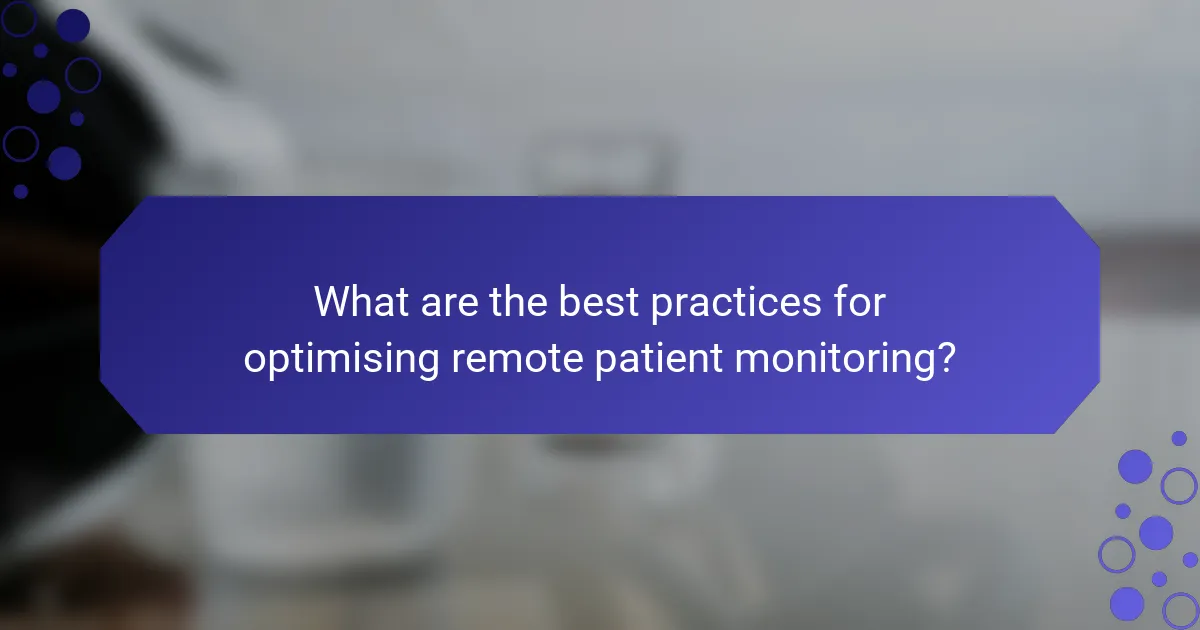
What are the best practices for optimising remote patient monitoring?
To optimise remote patient monitoring, implement user-friendly technology, ensure data security, and foster patient engagement. These practices enhance communication and improve health outcomes.
1. Choose intuitive telehealth platforms that facilitate easy navigation for patients.
2. Prioritise robust cybersecurity measures to protect sensitive health data.
3. Develop personalised engagement strategies, such as regular check-ins and feedback loops.
4. Utilise analytics to track patient progress and adjust care plans accordingly.
5. Provide educational resources to empower patients in managing their health.
6. Encourage collaboration among healthcare providers for comprehensive care.
Which metrics should be tracked for effective patient engagement?
To effectively engage patients through telehealth solutions, track metrics such as patient satisfaction, adherence rates, appointment attendance, and engagement frequency. These metrics provide insights into the effectiveness of remote patient monitoring and engagement strategies.
| Metric | Description |
|—————————-|————————————————–|
| Patient Satisfaction | Measures overall contentment with telehealth services. |
| Adherence Rates | Tracks patients’ compliance with treatment plans. |
| Appointment Attendance | Monitors the percentage of scheduled visits completed. |
| Engagement Frequency | Assesses how often patients interact with telehealth platforms. |
| Health Outcomes | Evaluates improvements in patient health conditions. |
| Technology Usage | Analyses the frequency of use of telehealth tools. |
What common mistakes should healthcare providers avoid in telehealth implementation?
Healthcare providers should avoid common mistakes such as inadequate training, neglecting patient privacy, and failing to engage patients effectively. These errors can hinder the success of telehealth solutions for remote patient monitoring and engagement strategies.
Inadequate training can lead to inefficient use of technology, resulting in poor patient experiences. Neglecting patient privacy may breach regulations and damage trust. Failing to engage patients through interactive tools can reduce adherence to treatment plans and overall satisfaction.
By addressing these issues, healthcare providers can enhance the effectiveness of telehealth implementations, ensuring better outcomes for patients.
